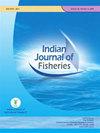Preservative effect of ready to disperse bioactive edible coating powder from fish protein hydrolysate incorporated with chitosan and active clove oil on tuna fillets (Thunnus albacares) during chilled storage
IF 0.3
4区 农林科学
Q4 FISHERIES
引用次数: 0
Abstract
Developing bioactive edible coatings is an emerging trend to improve nutritional value, food quality, and safety. The present work was undertaken to develop ready to disperse bioactive edible coating (BEC) powder from fish protein hydrolysate incorporated with chitosan and clove oil, and to evaluate their preservative effect (10 and 20% level) on tuna fillets during chilled storage at 4°C. Microbiological, biochemical, and sensory evaluation were carried out during 18 days of storage study. Aerobic plate count of tuna fillets treated with 10 and 20% BEC solutions showed 5.45±0.007 log cfu g-1 and 5.33±0.009 log cfu g-1, respectively at the end of storage, whereas the control sample reached 9.25±0.004 log cfu g-1. Among the BEC solution treated samples, 20% BEC solution treated sample had the lowest TBARS (Thiobarbituric acid reactive substances) value (1.68±0.04 mg MDA kg-1) followed by 10% BEC solution treated sample (1.93±0.02 mg MDA kg-1) at the end of the storage, while the control sample exceeded the acceptable limit (2.388±0.167248 mg MDA kg-1) on 9th day itself, which gave clear evidence that BEC solutions effectively extended the tuna fillet’s shelf-life. The overall study revealed that the sample treated with BEC solutions showed an excellent preservative effect on tuna fillets, which indicates the potential of combined use of these agents in food products. Keywords: Bioactive edible coating, Biochemical analysis, Chilled Storage, Sensory evaluation, Tuna fillets壳聚糖和活性丁香油混合的鱼蛋白水解物易分散生物活性食用包衣粉对金枪鱼鱼片的冷藏保鲜效果
开发生物活性食用涂料是提高食品营养价值、质量和安全性的新兴趋势。以鱼蛋白水解物为原料,加入壳聚糖和丁香油,制备了易分散的生物活性食用包衣(BEC)粉末,并对其在4℃冷藏条件下对金枪鱼鱼片的保鲜效果(10%和20%)进行了研究。在贮藏18 d期间进行微生物学、生化和感官评价。经10%和20% BEC溶液处理的金枪鱼鱼片贮存结束时好氧平板计数分别为5.45±0.007 log cfu -1和5.33±0.009 log cfu -1,而对照样品为9.25±0.004 log cfu -1。在BEC溶液处理的样品中,20% BEC溶液处理的样品TBARS(硫代巴比妥酸活性物质)值最低(1.68±0.04 mg MDA kg-1),其次是10% BEC溶液处理的样品(1.93±0.02 mg MDA kg-1),而对照样品在第9天就超过了可接受限度(2.388±0.167248 mg MDA kg-1),这清楚地证明BEC溶液有效延长了金枪鱼片的货架期。整体研究表明,用BEC溶液处理的样品对金枪鱼鱼片具有良好的防腐效果,这表明了这些试剂在食品中联合使用的潜力。关键词:生物活性食用涂层,生化分析,冷藏,感官评价,金枪鱼片
本文章由计算机程序翻译,如有差异,请以英文原文为准。
求助全文
约1分钟内获得全文
求助全文
来源期刊

Indian Journal of Fisheries
FISHERIES-
CiteScore
0.90
自引率
20.00%
发文量
0
审稿时长
6-12 weeks
期刊介绍:
Indian Journal of Fisheries is published quarterly by the Indian Council of Agricultural Research (ICAR), New Delhi. Original contributions in the field of Fish and fisheries science are considered for publication in the Journal. The material submitted must be unpublished and not under consideration for publication elsewhere.
Papers based on research which kills or damages any species, regarded as thratened/ endangered by IUCN crieteria or is as such listed in the Red Data Book appropriate to the geographic area concerned, will not be accepted by the Journal, unless the work has clear conservation objectives.
 求助内容:
求助内容: 应助结果提醒方式:
应助结果提醒方式:


